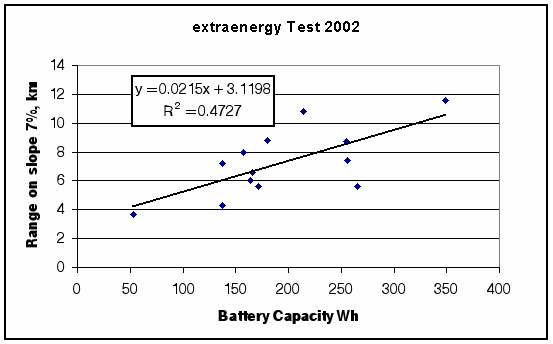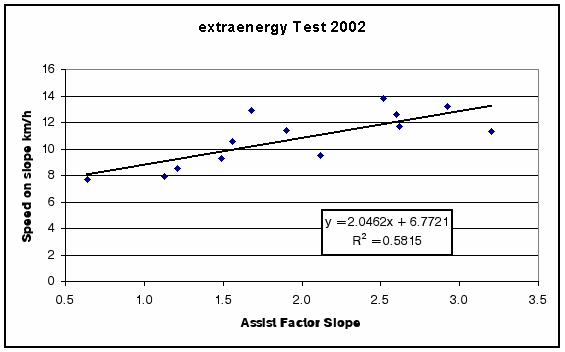
Contents | About | Contact
article 09, issue 02
Andreas Fuchs
October 15, 2005
[Links checked February 2009]
Abstract
The German non-profit organization ExtraEnergy tested human-electric hybrid vehicles in 2001 and in 2002, (e-bikes and pedelecs, see note). This paper compiles, visualizes and discusses the resulting data. Such compilations are helpful to benchmark new vehicles or drive systems, to show what levels of performance are common and to identify what kind of products are best suited for the user's intended application.

The Dolphin is an example of a commercially produced electric bike
A detailed description of these tests appears in ExtraEnergy's test reports [1] and [2]. Both trial series took place in realistic field conditions with many different riders. The tests were conducted both on mainly level and on mainly constant slope courses. On a "mixed track" portion of the testing, the riders stopped several times to simulate red lights. The distance vehicles were able to travel (range) was determined by riding until the batteries were considered discharged.
Differences between both tests were:
The format in which the test data was reported was different in 2001 and 2002. For easier analysis most of the data of both tests was compiled into a table. See Appendix.
In 2002 the amount of power assist was reported using the assist rate (R) and the assist factor (F). The assist rate is the ratio of the electric drive power (Pe), measured at the battery to the total mechanical power delivered to the drive wheel (Pw). The assist factor is the ratio of electric drive power (Pe) to the human supplied power as measured at the pedals (Php). If the assist factor is greater than 1, then the electric power is greater than the human's power contribution.
The assist rate and factor are derived as follows:
Php = Human power (pedalling power)
Pe = Power of the electric drive
Pw = Total drive power at wheel
R = Assist rate = Pe / Pw
F = Assist factor = Pe / Php = R / (1-R)
Because the human energy contribution (Php) is measured at the pedals instead of at the drive wheel, these relationships assume a pedal drive efficiency of 100% whereas the efficiency of the motor drive is unknown. [This means that the assist factor measured here is higher than the actual effective assist factor. Ed.]
These factors can be used to estimate the contributions of human power and electric power to range (at the same speeds):
Range using electric power only = total range * assist rate
Range using human power only = total range - range using electric power
only
Drive Performance and Energy Expenditure
It was found that most parameters hardly differed between the two tests.
However, in 2002 the average battery capacity was higher than in 2001: 193 Wh instead of 155 Wh.
Bike prices didn't vary much within the same classes. The average price, excepting the fast Swiss bikes, was about 1500 Euro.
Key results for both 2001 and 2002 were:
|
In detail: |
|||||
| x | Average | Standard Deviation |
Min | Max | |
| 2001 & 2002 | Vehicle mass (kg) | 29.1 | 5.6 | 18.1 | 42.5 |
| Battery mass (kg) | 5.9 | 3.2 | 2.2 | 15.6 | |
| Range on the level (km) | 29.9 | 8.3 | 15.0 | 49.6 | |
| Speed on the level (km/h) | 20.2 | 2.5 | 15.9 | 24.6 | |
| 2002 only | Range on slope 7% (km) | 7.3 | 2.3 | 3.7 | 11.6 |
| Speed on slope 7% (km/h) | 10.8 | 2.1 | 7.7 | 13.8 | |

[Figure 1] Ranges and average speeds of the tested bikes on the level.
The average of ranges was about 30km and the average of average speeds
was about 20 km/h. The top speed of most vehicles was (by law) under
24km/h in hybrid mode; that of the Dolphin 39 km/h.
Dividing range by battery capacity (see Appendix) gives energy use (including human power but not considering this in the calculation):
Using the assist rate (calculated from data in Appendix) one can easily estimate how far the human electric hybrids would have gone using only electric power (at the same speed): (Range * Assist rate) = Range using electric power only. The "purely electric range" would average 16.5 km and the energy use would average 12.4 Wh/km on the level.
If it is assumed that all tested bikes would have the same aerodynamic drag (effective frontal area assumed to be 0.5 m2) and rolling resistance (coefficient of rolling resistance assumed to be 0.007), then the ratio of the power needed to go on the level and to climb can be estimated. On the 7% slope at 11 km/h the total power required is about 2.5 times larger than on the level at 20 km/h. The ratio of energy use measured above is however 27 / 6 = 4.5. This is probably because at higher power levels the actual (in)efficiency of the electric drive weighs more strongly.

[Figure 2] Average speed and energy use for various models.
This shows that in general higher average speed leads to higher energy use (Wh/km) when riding on the level, but with considerable variations.

[Figure 3] Assist factor on the level and on the slope for various
models.
On average, the assistance does not change much from the level to the slope: on the level the assist factor is 1.23, and on the slopes 1.77. These ratios are higher than the 1 : 1 factor much promoted and discussed in the 1990's.
These figures also show that while in many cases the assist factors do not differ much between level and slope, those of vehicles made in the hilly and alpine regions of Europe have much higher assist factors on slopes than on the level.
By plotting parameters against others one can try to identify those most important for the performance.
We plotted the "performance parameters" like range and speed over the "feature parameters" like price, weight of vehicle, weight of battery, assist factors in order to identify trends that could exist. Here are some results of interest.
We would like to know the answers to questions like: "Do the lighter or the heavier bikes climb better?" "Does range on the level change much with average speed ?"
In the graphs below, a linear regression line with an upward slope shows a positive correlation. The figure R2 gives the degree correlation between the parameters, from 0 (no correlation) to 1 (strong correlation).

[Figure 4] Speed on slope vs. battery capacity.

[Figure 5] Speed on slope vs. assist factor.
|
Other (mainly expected) correlations: |
||||
| Year of Test | Parameter 2 | Parameter 1 | Slope | R2 |
| 2001 | Max. speed | Price | 0.007 km/h/Euro | 0.72 |
| 2001 | Speed on slope | Battery capacity | 0.04 km/h/Wh | 0.38 |
| 2001 | Speed on slope | Mass of Bike | 0.32 km/h/kg | 0.36 |
| Both years | Range on the level | Battery capacity | 0.074 km/Wh | 0.29 |
| 2002 | Speed on the level | Assist factor | 1.94 km/h/[-] | 0.24 |
| 2002 | Range on the level | Assist factor | 6.5 km/[-] | 0.19 |
| Both years | Energy use on the level | Speed on the level | 0.3 Wh/km/km/h | 0.17 |
Examples for unexpectedly weak correlations:
The vehicles in the 2001 test climbed faster the heavier they were, since the available power depends on the mass of the motors and batteries, in contrast to unassisted bikes, where the opposite is true. [This implies an optimum configuration for each hybrid operating point. Ed.]
Additionally, if batteries are dimensioned too small, the discharge efficiency is low at high power levels and therefore the range on slopes decreases.
The data may also be used to visualize general facts for individual vehicles or average values.

[Figure 6] Averages of average speed vs. average slope.
Average speed on the level is about 20 km/h (all samples), the maximum average speed 24.7 km/h (Velocity Dolphin). [Personal experience with the Dolphin also shows a much flatter curve. Ed.]
At 10 % slope the tested vehicles go nearly 10 km/h.
The dashed line is an extrapolation and suggests a maximum climbing slope of 18%. Exact values would depend on the actual gearing.

[Figure 7] Average climbing height vs. horizontal distance.
Such graphs in sales literature would help consumers decide on the suitability of vehicles for the planned usage.
An e-bike may be defined as a bicycle equipped with an auxiliary electrical motor which operates independently from human power
input. A pedelec (pedal electric) is a vehicle
equipped with an auxiliary electric motor that operates only when the
rider
pedals. A legal definition of a pedelec at: ExtraEnergy.org.
[1] 2001 Test, Extra Energy e.V., Testbericht.pdf
[2] Pedelec / E-Bike-Test 2002, Extra Energy e.V., TestberichtRaeder.pdf
Spreadsheet of 2001 and 2002 tabulated results; public access (zipped XML) format (appendix.sxc 11 KB) or proprietary format (appendix.xls 16KB)
Dr. Andreas Fuchs (born 1963), at the date of publication worked as a researcher at the the
Berne University of Applied Sciences, School of Engineering and Information
Technology in Biel, Switzerland, and led projects with human electric hybrid vehicles. Fuchs and Juerg Blatter developed a chainless
transmission for pedal powered machines in the periods 1996 to 1998 and 2000 to 2002.
Andreas may be contacted at:
Gutenbergstrasse 24, CH-3011 Bern, Switzerland, +41 79 294 06 93,
andreas.fuchs AT bluewin DOT ch
Human Power eJournal